
18 min
0
10.04.2022
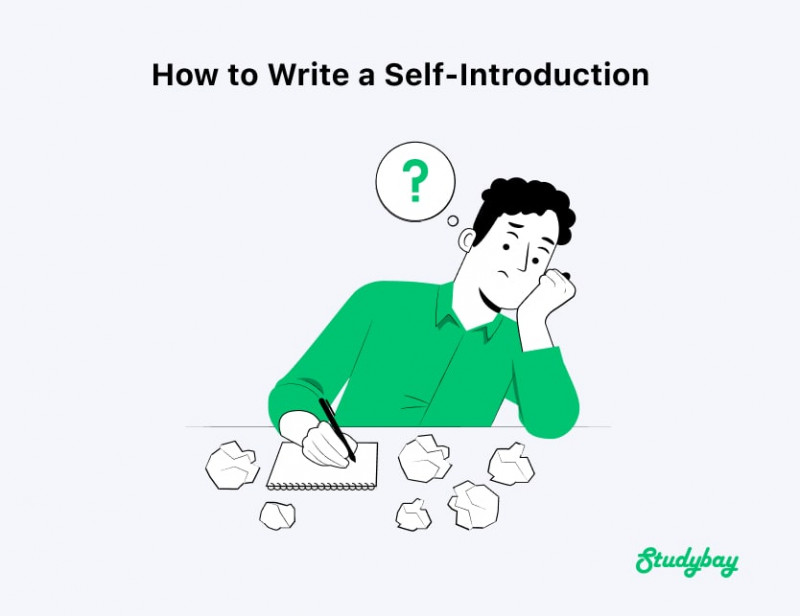
Self-introduction is an inevitable part of daily interactions within your social, academic, and professional circles. As we transition to new neighborhoods, colleges, and workplaces, we have to introduce ourselves and our brand and start making connections early.
But how do you do it right?
Social anxiety is a significant hindrance to feeling confident around new people or delivering a speech to a group of strangers. According to statistics, 12.1% of U.S. adults experience it at one point in their lives.
That should no longer be the case for you the next time you have to introduce yourself or write a self-introduction assignment that you’ll present in class.
Let’s look at what a self-introduction is, why it is important, and how to write a self-introductions.
What is a Self-Introduction
A self-introduction is an explanation of who you are, what you do, and what others need to know about you. A self-introduction is necessary whenever you meet new people within a social, academic, and professional setup, and often, there’s no mutual third party to introduce you.
Typically, you’ll deliver a self-introduction in the following scenarios:
- At the beginning of an interview
- When networking for new connections
- When attending a hiring event
- When meeting new people at a trade show
- When giving a presentation
A self-introduction essay typically includes your name and occupation or desired occupation, plus a selection of critical facts that will draw the audience towards you and make a great first impression and get a positive feedback.
A compelling introduction about yourself spans only a few sentences while covering vital information about yourself. This information should leave a lasting positive impression that will facilitate healthy and productive interactions between you and the new company.
A self-introduction can be delivered in written form, read out to your audience, or sent via email when contacting a new professional contact.
At some point during your career parth, you will need to introduce yourself in a professional manner. This can happen during the interview process, at networking events, or when participating in a hiring event like a job fair. Remember to always be polite and courteous, as first impressions are very important.
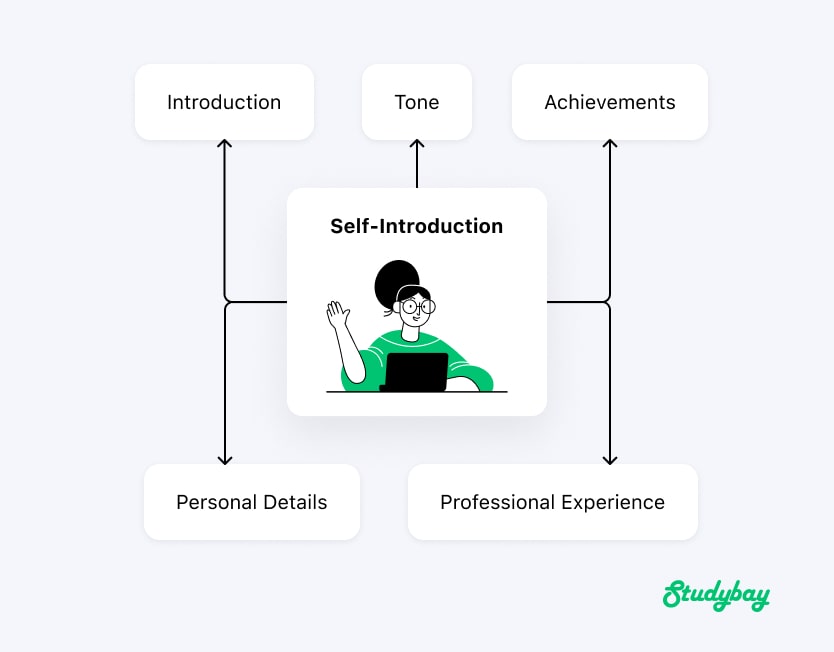
What’s the Importance of Writing a Self-Introduction?
If you’re about to join a new team professionally, writing an employee self-introduction email shows your enthusiasm to get to know everybody and start participating in the team’s activities. Your coworkers get brief professional background information about you and the role you’ll be taking, which prepares them to interact with you better in a professional context.
Early interactions also solidify future connections and interpersonal relationships that can propel your career path further.
Building these foundations is vital given your limited time interacting with different people in environments such as job interviews. You want your introduction to leave a positive first impression that will demonstrate you’re the right fit for the new job.
In a social setup, you want the new company of friends to feel that you’re a polished and respectable individual who is laser-focused on what they want to do in life and have a career goals and academic life ahead.
University professors sometimes require their students to learn how to write personal introduction to hone their skills and personal goals for their careers and future job interviews. In such cases, the student may write the self-introduction themselves or have someone write a self-introduction online for them.
How to Write Self-Introduction
Whether you deliver your self-introductions verbally or in writing, it’s important to draft a sample of what you’ll say in advance to ensure you’ve touched on all the main points and will deliver your compelling story. Therefore, you must know how to introduce yourself in writing.
If you’re going to present the yourself verbally, you should do a few practice rounds to solidify the key points in your mind and ensure you’re fully prepared to deliver all the essential details. Don't forget about your body language and eye contact when presenting yourself.
If you’ll send it via mail, the draft can help you refine the key points and details so that you leave a positive first impression and guarantee you pass the interview or win the pitch for the project.
General Points to Cover
These are the steps you should follow when writing an introduction about yourself.
Summarize Your Professional Standing
Typically, you’ll want to include your name, job title, or experience in the first sentence of your self-introduction. These details typically feature in the “introduction.”
If you’re job hunting or unemployed, you can substitute your job title or experience with a mention of your college degree, for example bachelor's degree, certification level, or your current job searching stage.
For instance, if you’re job hunting, you can start your self-introduction with:
Alternatively, you can start your introduction this way:
If you’re employed, you can mention your current position:
Expand on Your Experiences and Achievements
This part fits nicely in your body and forms the gist of it. It highlights the most relevant details to the reader or listener and aims to grab their attention and showcase your expertise.
For instance, if you’re in for a job interview, you can use this section to discuss your accomplishments and professional skill set:
If you’re speaking at an event, you can use this section to highlight why you’re an authority in the area you’re speaking on by giving brief examples of your experiences and achievements within that field:
If you’re handling a new client, you can use this section to mention your products and services plus your brand’s achievements in the market.
Conclude with a Segue to the Next Part of the Conversation
The purpose of a self-introduction is to introduce yourself to the other party and break the ice for a further, more in-depth conversation. Therefore, the last conclusion to your self-introduction should be the segue to the next part of the conversation.
How you frame your conclusion will vary depending on the type of conversation you’re supposed to have.
For instance, if you’re supposed to give a presentation, conclude by summarizing what you intend to discuss:
If you’re in an interview, finish by mentioning why your education, skills, and accomplishment make you an excellent fit for the role:
If you’re introducing yourself to a new colleague or a possible network at a networking event, you can conclude by prompting them to introduce themselves or follow another call to action. For instance:
The Present, Past, Future Framework
When deciding what to include when introducing yourself, try to keep a time frame in mind. It is the most basic template. It is divided into three parts the present, the past, and the future.
Present
You should write your introduction using a present-tense statement such as:
Using the present tense for your introduction establishes your identity at the moment giving the reader or your audience a clear understanding of who you are and what you do currently.
You can also use this opportunity to share more than your name and job title if the time, context, and audience allow, diving into other details such as your expertise, current project, and geographical location.
Past
The second part of your introduction is typically written in the past tense since you’re highlighting your experience and achievements. These details furnish your background and establish credibility. In this section, you can mention your education, employers, past project, and accomplishments.
You can treat it as the body to your self-introduction.
Future
The last part of this framework is future-oriented. Therefore, you’ll write most portions in the future tense, demonstrating enthusiasm for what lies ahead.
For instance, if you’re in a job interview, this section will show your eagerness to join the new team in the applied role and describe your personal goals. If you’re in a meeting, you can express interest in the topic. If you’re part of a project, you can share your ambitions for the project and your excitement for its future.
What to do for an Email
Delivering self-introductions via email requires a few changes and additions. Also, you can check other useful tips on how to write an email from our experts. Here is what to write in self-introduction email:
Write a Friendly Subject Line
Your employer’s or colleague’s email is typically flooded with hundreds of unopened emails. If you want them to view your introduction, you have to give it a friendly but captivating subject line.
Using a friendly and captivating subject line is also crucial since, given you’re new, your coworkers and employer may not be able to recognize your email address easily.
Some appropriate subject lines you can use include:
Subject line 2: “Hello” from [name], your new [position]
Select a Tone Based on the Company’s Culture
Your company’s culture should dictate the tone of your introduction email. For instance, if your company culture is more laid back and open, you can use an upbeat and friendly tone. You should keep your self-introduction email straightforward and polite for a more serious and professional space.
Explain Why You’re Writing the Self-Introduction
If you’re delivering your self-introduction via email, don’t jump straight to the gist. Start by explaining why you’re writing the self-introduction. Explain that you’re a new person at work or new contact and are eager to know your colleagues or network and build an effective communication in your workplace.
Then, the rest of your self-introduction can cover the general points or follow the present, past, and future framework.
Reply to Follow-Up Questions and Emails
Some team members or contacts may have follow-up questions. Feel free to reply to them and do so promptly. This is often a good sign that you’ve started building relationships. Email conversations can offer a good starting ground for face-to-face conversations at a later stage.
Examples of Self-Introduction for Different Scenarios
If you're wondering what a good self-introduction example is, we have a few for various scenarios that might aid you when writing one.
Introduction About Myself Sample – as a Student
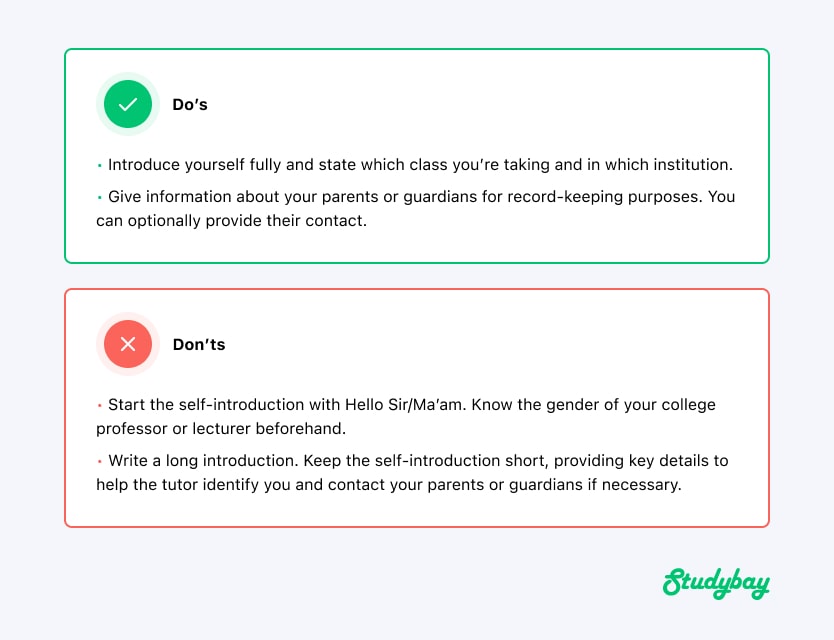
Introduction Paragraph Examples About Yourself - Recruiter Sample
|
My name is Greg Holland, a career writer, and expert. I offer job seekers expert advice on several career-related topics. I have read many career books and still engage my community on career matters. I also consult regularly with other recruiters so that I can take the recruitment load off your back. I’ll show you how to maneuver the recruitment process, create a winning resume, and excel at your job interview. |
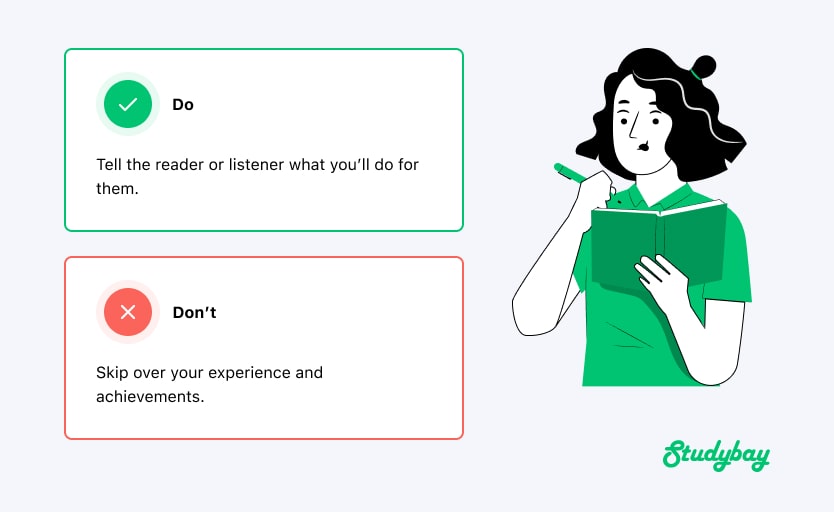
Introducing Yourself in Email Self-Introduction Sample
|
Subject: Hello from Linda, Your New Geospatial Engineering Student Dear Ms. Faith, My name is Linda West, and I’m your new geospatial engineering student at Fort Green University. I’m writing this email to introduce myself fully, as agreed earlier in our first meeting. I’ll also mention my interests and share my contacts and my parents’. I’m a first-year student living in Bethany campus hostels. I studied at Corsair High School and graduated in 2020. My dad’s name is Humphrey West and my mom’s Riley Beth. My dad works as a marine, and my mom is a businesswoman. I have an interest in acting. Therefore I’ve already joined the drama club. I hope we have more meaningful interactions in the future as you help me chart my academic path. Thank you. Look forward to your reply. Regards, Linda West |
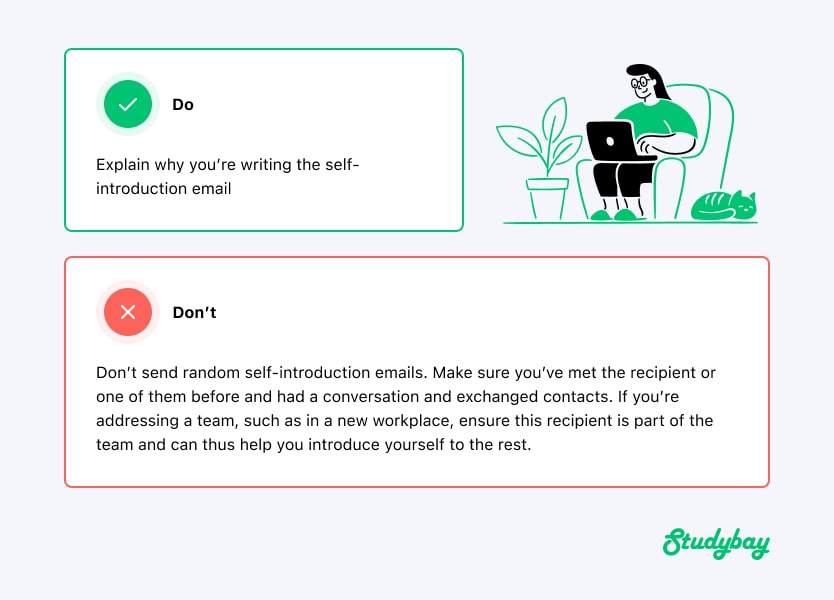
Introducing Myself Example - a Job Interview
|
Hi, my name is Sam Jones. I’m a graphics designer with over six years of experience. I’ve specialized in website and brand design, creating unique and beautiful layouts that will leave your users mesmerized. I’ve worked with over 50 brands, walking them through the process of font selection, colors, and content for their websites and brands. I’m looking forward to using my skills to propel your business to a new branding and graphics design future and working closely with your team to realize different ways we can visually target your customers. |
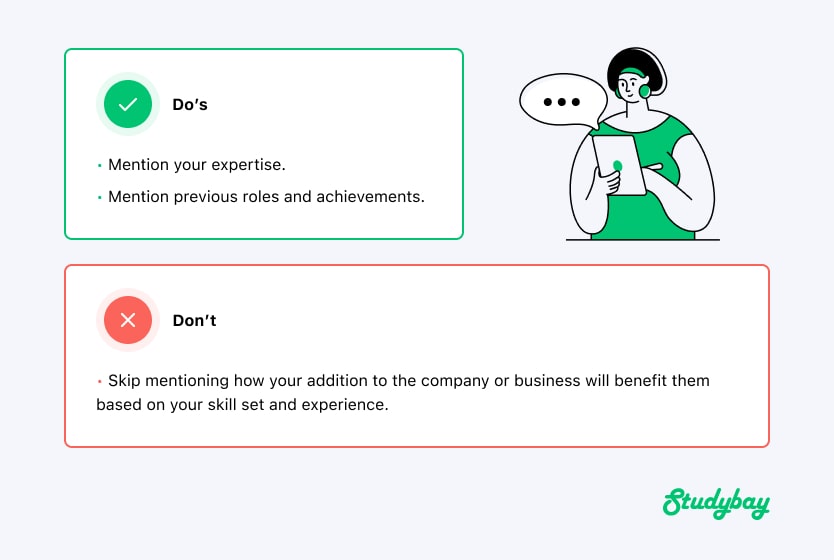
Self-Introduction Paragraph Examples - The First Day at Work
|
Hi Everyone, My name is Carl Lincoln, and I’m the new lead software engineer at Tech Specialists Ltd. I am writing to formally introduce myself to the entire Tech Specialists fraternity and share a little bit about my position on the team. As the lead software engineer, I’ll be in charge of all software engineering projects carried out by the company. I’ll work with the competent team of project managers led by Ashley White to oversee the timely delivery of software engineering projects according to the high-quality standards set by our QA, Marcus Brown. I’ll also be in charge of adopting new technologies and platforms to enable Tech Specialists Ltd to deliver cutting-edge cloud services to our B2B customers. I am confident that with the support of Ashley, Marcus, and our CIO Britney Houston, together with their teams, we’ll be able to realize a new tech era for Tech Specialists Ltd. During my application, I noticed a very warm and embracing culture at Tech Specialists Ltd., which I wish to cultivate in my role here. I hope to meet all of you soon and better understand your culture and systems, and be part of this big family. I’d like to share a few details about my previous professional experience working for Cloud-ly LLC. Prior to taking this role, I was the lead backend engineer. I’ve worked with clients in the food, medical, and manufacturing industries. If you have any questions, please feel free to reach out to me directly. Best, Carl Lincoln |
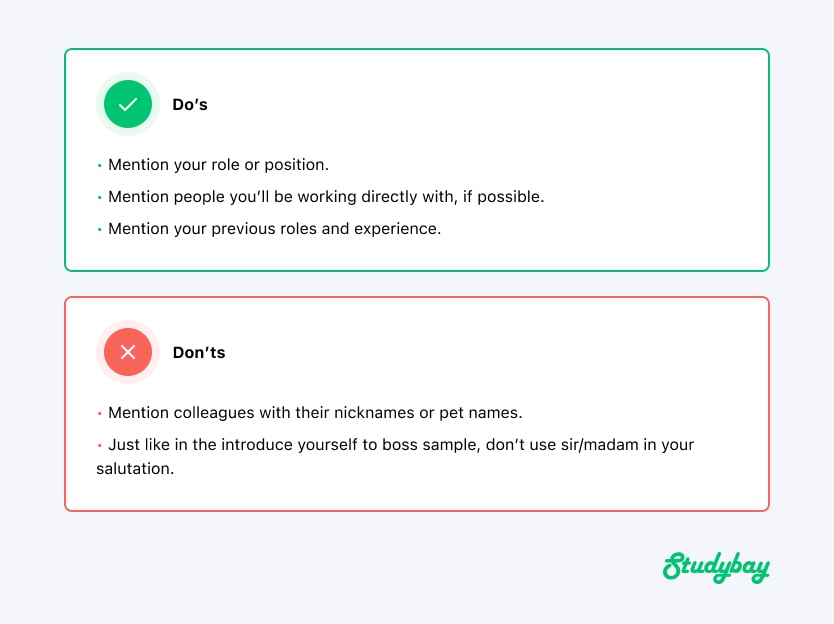
Tips and Tricks on How to Write a Personal Introduction
The following are tips and tricks you can use to nail how to write self intro.
They can also tell you what to write in a self-introduction.
Mention Your Professional Experience When Necessary
If you’re writing a self-introduction for a job interview or to your new colleagues after joining as a new hire, then you must highlight your professional experience.
Within the formal setup, mentioning your professional experience gives you credibility among your colleagues and, if you’re interviewing for a new job, gives the hiring manager confidence in your skills and professional abilities.
Be Unique
In your self-introduction, mention something that makes you stand out. It's one of the most important things. Remember, a strong introduction about yourself should leave a lasting impression on your reader or listener. Mention any remarkable professional achievement you’ve made, a creative task you completed, great ideas you’ve worked on, or a landmark project you participated in.
Keep the Format Simple
If you’re submitting a written self-introduction, stick to a simple and concise format that’ll be easy to read and understand. Keep the introduction short and head directly to the other relevant information.
Proofread the Work
If you’re submitting a written self-introduction, proofreading is crucial to ensure you don’t have grammatical mistakes or any other errors that might leave a poor impression on the reader. Use professional tools such as Grammarly to check your work before sending it to the relevant party.
Consider the Context of the Self-Introduction
Your self-introduction must adapt to the situation you’re in. Your tone must differ depending on who you introduce yourself to and their culture.
For instance, you have to be very formal when introducing yourself to a hiring manager, but you can afford a bit of casualness when introducing yourself to your peers on the first day of class in college.
Reference: NIMX Prevalence of Social Anxiety Disorder Among Adults
FAQ
How To Prepare A Self-Introduction?
For a written self-introduction, you should prepare a draft covering all key areas, then proofread it before submitting it to the relevant party.
If you’re going to present it verbally, take some time to recite the self-introduction, mastering the key points and ensuring that you’ll fluently and correctly deliver it.
How Do I Write About Myself?
Using a concise format, you can tell your reader or listener about yourself, what you do, and your aspirations, given the context.
Alternatively, if you do not know how to write about yourself, you can hire a writer to write your personal statement through a service like Studybay.
What Is A Good Introduction?
A good introduction tells your audience about your present, past, and future. Therefore, it informs them about your current role, your experience and achievements, and your aspirations for the future working or interacting with them. You can consider it a more compressed form of cover letters.
What Is A Brief First Introduction Of Yourself?
A short introduction about yourself is often known as a self-introduction or self write up. It’s written to quickly introduce and describe you to a recruiter, college professor, new colleagues, or new networks.



